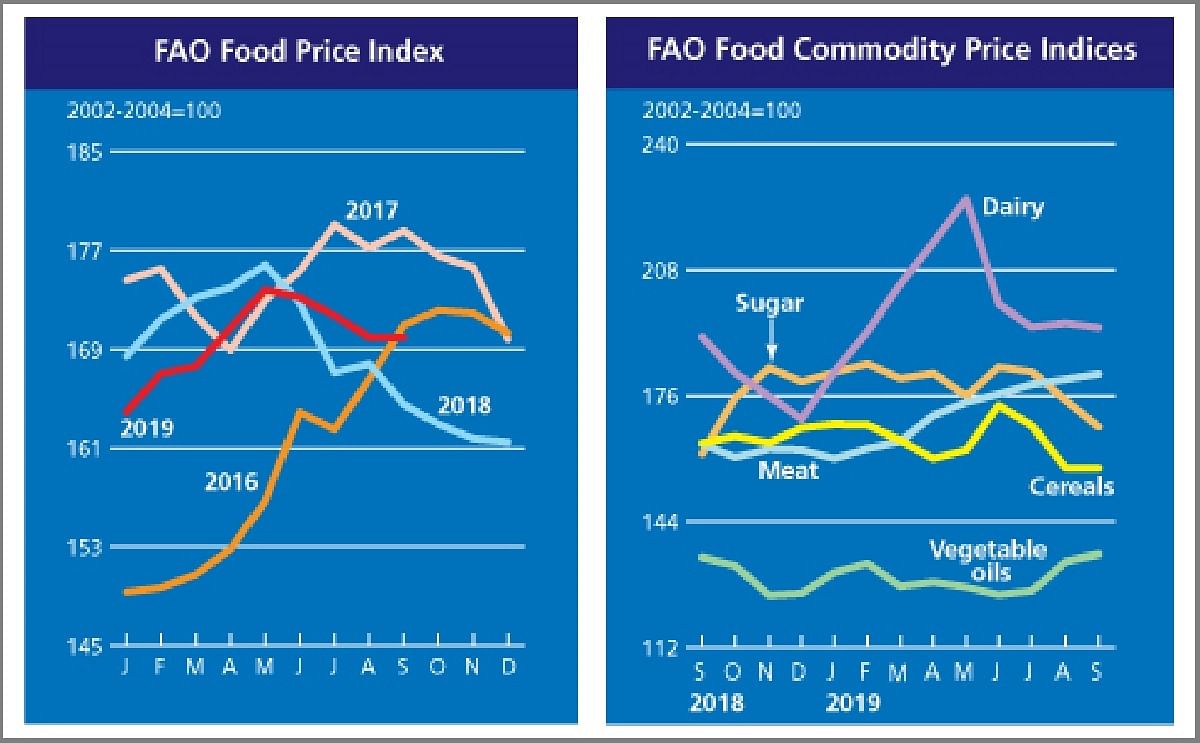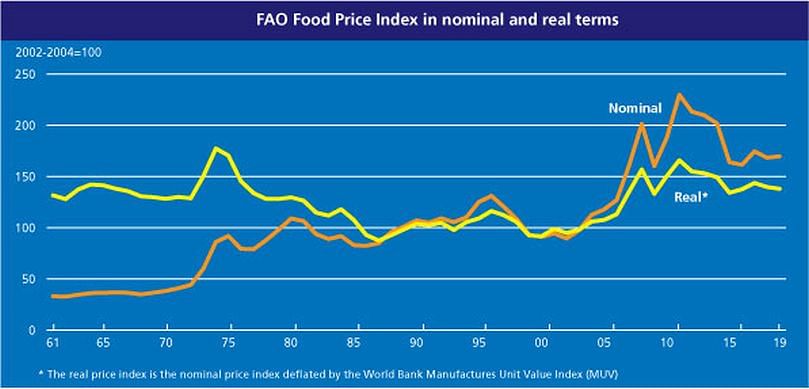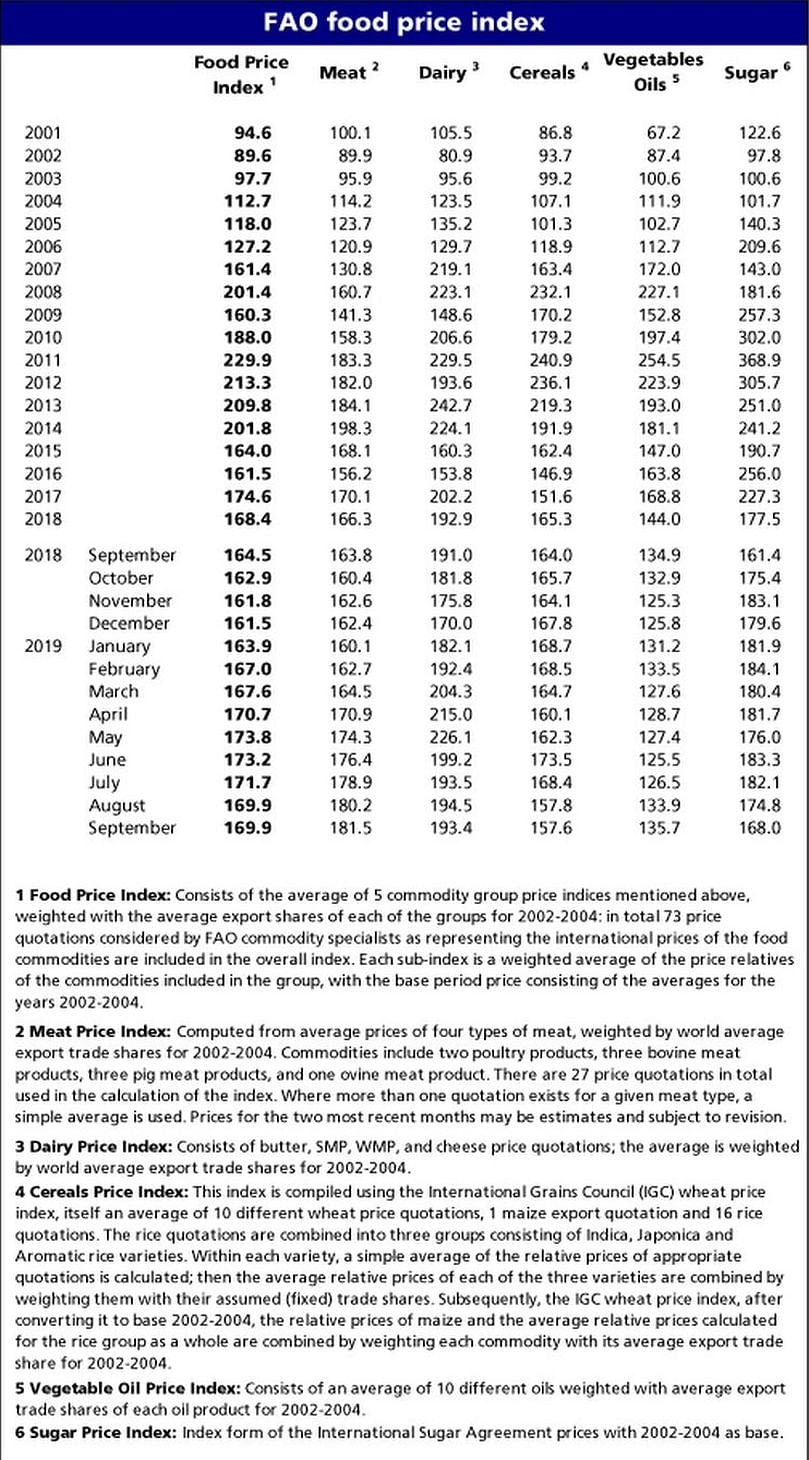FAO Food Price Index held steady in September, remaining above last year’s level.
FAO Food Price Index held steady in September, remaining above last year's level

The FAO Food Price Index* (FFPI) averaged nearly 170 points in September 2019, unchanged from August but 3.3 percent higher than in the corresponding period last year. While in September sugar prices fell sharply, the decline was almost entirely offset by higher prices of vegetable oils and meat. The Dairy index was down only marginally, whereas that of cereals remained steady.
The FAO Cereal Price Index averaged 157.6 points in September, nearly identical to its August average and down 3.9 percent (6.4 points) from September 2018. However, among the major cereals, prices moved in different directions.
Wheat prices were firmer in September amid brisk trade activity, though they remained well below (by 11 percent) the same time last year, pressured by the overall good supply outlook.
By contrast, maize price quotations were down month-on-month, as international prices continued to slide because of large export availabilities in both southern and northern hemisphere exporting countries.
International rice prices were steady to mildly lower in September, as the support provided by seasonal tightness and currency movements was countered by slow import demand and uncertainties surrounding policies in the Philippines and Nigeria.
The FAO Vegetable Oil Price Index averaged 135.7 points in September, up 1.8 points (or 1.4 percent) from August, marking the highest level in 13 months. The modest increase mostly reflects higher price quotations for palm and rapeseed oils, whereas those for soy and sunflower oil fell month-on-month.
While international palm oil values rose on steady import demand from India and China, rapeseed oil price quotations continued to increase, fuelled by the EU’s deteriorating production outlook amid firm demand from the biodiesel sector. In addition, rising crude mineral oil prices lent support to vegetable oil values.
By contrast, soy and sunflower oil prices dropped on account of, respectively, sluggish global import demand and prospects of large supplies in the Black Sea region.
The FAO Dairy Price Index averaged 193.4 points in September, down 0.6 percent (1.1 points) from the previous month but still 1.3 percent higher than its value in the corresponding month last year. In September, price quotations for cheese and butter fell, especially at the lower end of the price range.
Moderate increases in export availabilities, principally in New Zealand, where milk production is nearing the seasonal peak, contributed to the decline.
By contrast, Skim Milk Powder (SMP) and Whole Milk Powder (WMP) price quotations firmed on strong import demand amid limited export availabilities, especially in Europe.
The FAO Meat Price Index* averaged 181.5 points in September, up 0.8 percent (1.4 points) from August, continuing the moderate month-on-month price increases observed since February 2019. In September, price quotations for ovine and bovine meats continued to firm on solid import demand, especially from China, despite elevated export availabilities in Oceania.
By contrast, while domestic pigmeat prices in China - the world’s largest market - remained at the high levels recorded the previous month, pigmeat prices in international markets tended lower, pressured by increased export supplies in Europe.
Price quotations for poultry meat remained stable, as export availabilities were adequate to meet import demand.
The FAO Sugar Price Index averaged 168.0 points in September, down nearly 6.8 points (3.9 percent) from August. The month-on-month decline was largely driven by the expectation of ample sugar stocks due to positive production prospects for the upcoming 2019/20 marketing season.
Furthermore, weaker international energy prices in the second half of September contributed to the decline in international sugar prices by encouraging producers to reduce the use of sugarcane for the production of ethanol, notably in Brazil, the world’s largest sugar exporter.














